The Microsoft Surface Laptop 3 Showdown: AMD's Ryzen Picasso vs. Intel's Ice Lake
by Brett Howse & Andrei Frumusanu on December 13, 2019 8:30 AM ESTSystem Performance
Moving on from SPEC to some of our more traditional laptop tests, I’ve taken the opportunity to add some new tests to the suite, which we’ll include on all laptops going forward. While SPEC is a fantastic set of tests to probe the limits of a platform, not everyone is going to run a workload that runs at nearly 100% CPU utilization for such a long time on a laptop. The 8-Thread tests took 4.5 hours to complete on Ice Lake, and 6.5 hours to complete on Picasso, which is likely not something most people would turn to a thin and light laptop for, so it’s important to see how both platforms perform on shorter tests where they can leverage their peak boost frequencies for a higher percentage of the duration.
PCMark 10
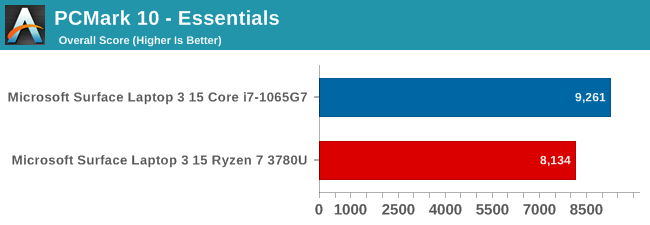

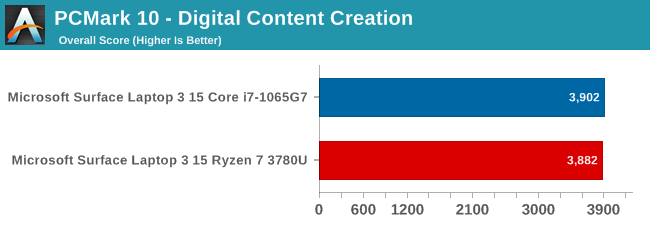
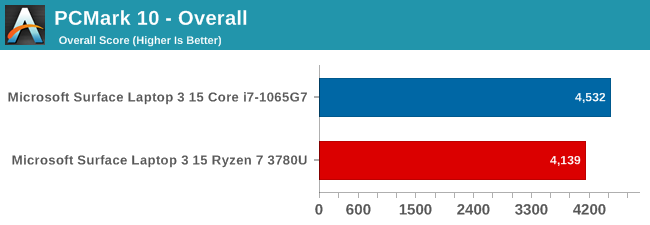
PCMark 10 consists of several real-world tests, including web, video conferencing, spreadsheets, writing, and more. There are several GPU tests as well, including rendering, and some gaming. The suite also measures application start-up, and all aspects of the system’s performance factor into the score.
Intel’s CPU performance lead shows clearly here again, with significant leads in both the Essentials and Productivity tests, although AMD’s strong GPU pulls the Ryzen system very close on the Digital Content Creation tasks. But that is not enough to turn the tide, and the Ice Lake platform carries this win.
Cinebench R20
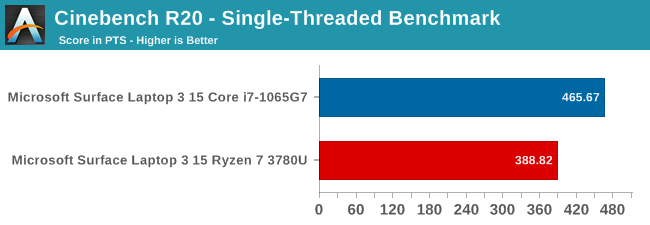
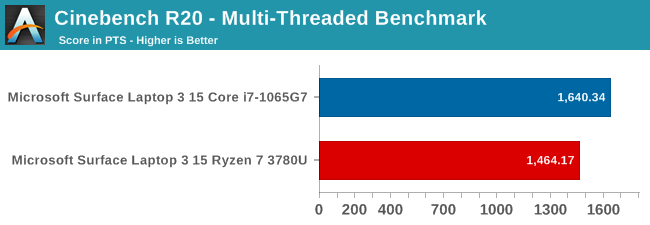
Looking at the latest version of Cinebench tells a similar story as to what we’ve seen so far. Ice Lake’s significant IPC lead pulls it way ahead. On the multi-threaded test, the AMD platform does close the gap somewhat, which is similar to the SPEC rate 8 results.
7-Zip
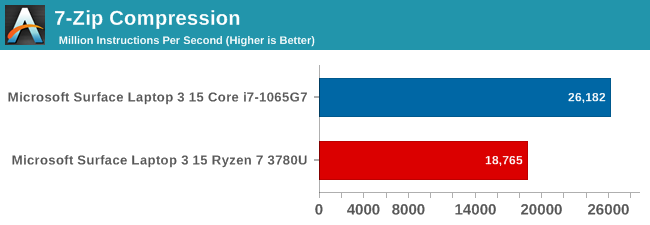
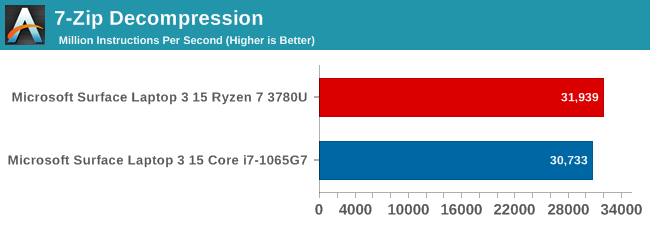
Checking out the popular 7-Zip file compression tool, the results are in-line with what we see in the desktop space. Intel generally has a lead on the compression side, but AMD claws back at decompression. It is a rare win on the CPU side for AMD here.
Handbrake
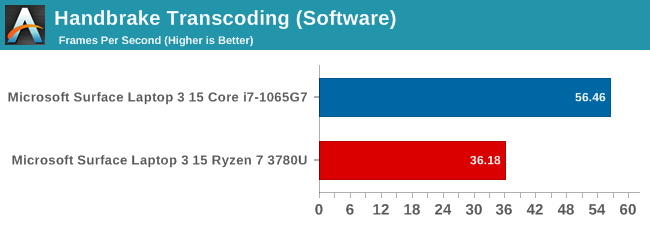
Transcoding is a popular task, and Handbrake is one of the most popular tools. For this test, a 1080p movie is converted to 720p using the x264 encoder. Once again, Ice Lake offers significantly more performance when transcoding in software.

Handbrake also supports various hardware encoders, such as Intel’s QuickSync, which provides significantly quicker transcodes at the same settings – albeit at larger file sizes and slightly lower quality compared to the software transcode, according to the Handbrake documentation. QuickSync has been very popular, and has been around quite a while. AMD also offers hardware encoding and decoding with their Video Core Next platform. Handbrake does support AMD’s Video Coding Engine (VCE) but the Surface Laptop 3 does not offer this as an option in Handbrake, so it was not able to be tested. As this is the only current Ryzen mobile APU we’ve tested, it may be a driver issue specific to the Surface branded processor.
x264
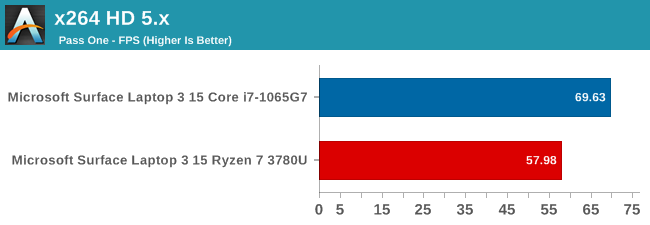
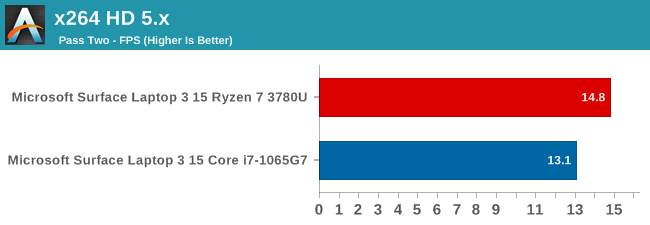
Our previous transcoding test, x264, was also run. Here we see that once again Ice Lake has a significant performance advantage, as it did with Handbrake software encoding.
Web Tests
All of our web tests were run with the current version of Microsoft Edge in Windows 10 1909. Web results are highly impacted by the underlying scripting engine, and Microsoft is going to be moving Edge from the EdgeHTML rendering engine to the Chromium open-source project that powers Google Chrome. When they make this change, expected early in 2020, we’ll revamp our suite with new tests.
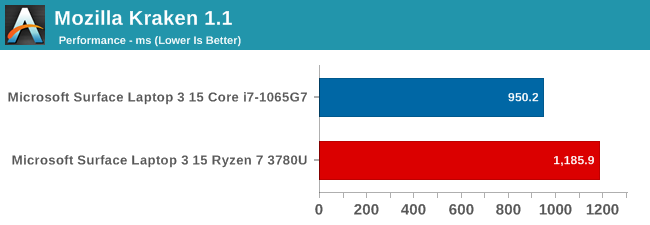

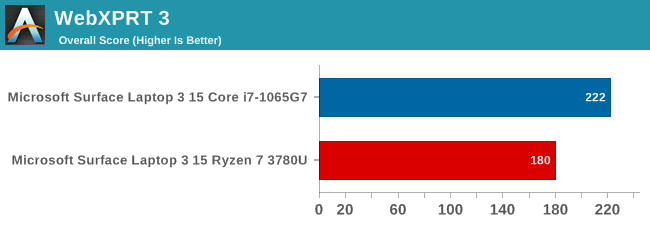
Intel has aggressively pushed their frequency ramping with Speed Shift, and one of the biggest beneficiaries of Speed Shift is web scripting, since the tasks tend to be very short. AMD is addressing this in Zen 2 with Collaborative Power Performance Control 2, or CPPC2, which is not as elegant of a name as Speed Shift, but promises to drop Zen’s frequency ramping from ~30 ms to ~1 to 2 ms, and will be a welcome addition on our web tests.










174 Comments
View All Comments
Fataliity - Friday, December 13, 2019 - link
And I dont see a single page about temps? Is that because it runs at 90-100 C?extide - Friday, December 13, 2019 - link
There is an entire page of graphs with temps...dullard - Friday, December 13, 2019 - link
Exactly, but looking at Fatality's post above, it did not appear like Fatality wanted to see the actual truth. The CPU temps were not much different.https://images.anandtech.com/doci/15213/PCMark10.p...
Fataliity - Friday, December 13, 2019 - link
Every other website shows temps here.https://openbenchmarking.org/embed.php?i=1911040-H...
Over 90 celsius.
That single graph isnt a good comparison for temps. That's why its littered with 'frequency' and 'power'. to distort it.
Fataliity - Friday, December 13, 2019 - link
So it's not about "Not wanting to see the truth" It appears either anandtech's truth for temps is based on light workloads where the cpu isn't stressed at all, or possibly just wrong.Fataliity - Friday, December 13, 2019 - link
And this is supposed to be a "Showdown" between Ryzen and Intel. Not a "spotlight" or "sponsored" intel piece. So the way things were presented is very biased.I fully expect Intel's CPU to beat Ryzen, thats for sure. And graphics on higher than value setting, Ryzen scores about 5-10 fps higher. But on this review, It's intentionally skewed for Intel.
You should've just made a separate article for each if you were planning on favoring one company. And show their positives and negatives. Not focus on every possible positive of Intel and hide everything negative.
It's just not right, where people expect you to give a non-biased review to base their purchase off of.
Fataliity - Friday, December 13, 2019 - link
https://www.phoronix.com/scan.php?page=news_item&a...Link to article where graph is from.
Fataliity - Friday, December 13, 2019 - link
And how it actually performs in gaming, when your not using the IPC of Ice Lake to increase performance. The guy has plenty other videos if you care to watch.https://www.youtube.com/watch?v=B9FgYx2z0NY&t=...
maroon1 - Saturday, December 14, 2019 - link
PointlessThis is apu vs apu. It should be compared the way it is made
dullard - Friday, December 13, 2019 - link
1) Anandtech posted multiple graphs, I just linked one. Please actually read the article and look at all the data before posting here.2) Having additional data on a graph does not distort the temperatures that were measured.
3) You can't compare one laptop's temperature to another completely different laptop's temperature and have any conclusions that are valid (your link to a Dell XPS is not compariable to this article on a Microsoft Surface). This is because each laptop has completely different cooling systems, fan speeds, etc.
4) The temps were done doing things like multi-threadded Cinebench. If that is too light of a load for you, feel free to do your own test and post them here. https://images.anandtech.com/doci/15213/CinbenchR2...